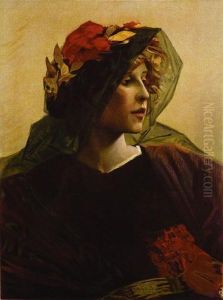Alfred Pierre Agache Paintings
Alfred Pierre Agache, also known as Alfred-Pierre Agache or simply Alfred Agache, was a French academic painter born on August 29, 1843, in Lille, France. He is best known for his portraits and allegorical works, which were highly regarded in the French academic tradition of the late 19th century. Agache studied at the École des Beaux-Arts in Lille before continuing his education in Paris. He was a student of the famous French painters Jean-Léon Gérôme and Alexandre Cabanel, who were both prominent figures in the academic art world.
Agache's painting style was characterized by its fine detail, use of rich colors, and classical themes, often incorporating mythological and allegorical figures. He gained recognition for his work in the 1870s and 1880s, exhibiting at the Paris Salon, an annual art exhibition hosted by the French government. His submissions to the Salon were often well-received, earning him medals and distinctions, including the prestigious Legion of Honor in 1896.
Notably, Agache's painting 'Vanity' received considerable attention for its technical skill and thematic depth. He also painted murals for public buildings, which further enhanced his reputation as an accomplished artist of his time. Despite his success, Alfred Agache is not as well known today as some of his contemporaries. This can be attributed to the decline in popularity of academic art in the face of new artistic movements such as Impressionism and Post-Impressionism, which emerged toward the end of the 19th century and began to dominate the art scene.
Agache's work was part of the art collections of many prominent individuals and institutions during his lifetime. However, as tastes changed and the art world evolved, his name and work receded from the spotlight. Nevertheless, those who study 19th-century French art continue to recognize Agache as a talented painter who contributed to the richness of academic art.
Agache died on September 15, 1915, in Paris. His legacy lives on through his paintings, which can still be found in museums and collections around the world, serving as a testament to his skill and dedication to the academic art tradition.


